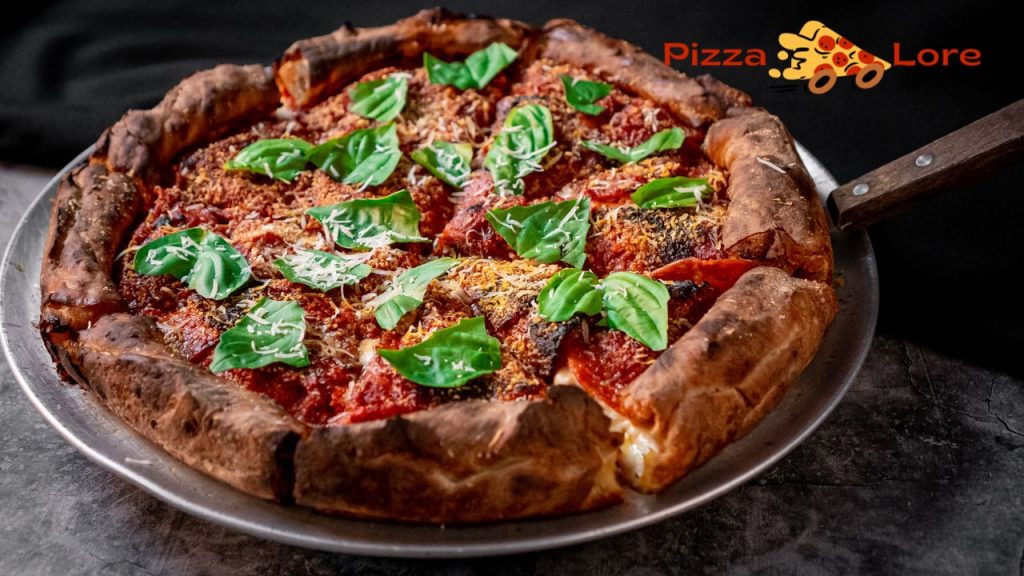The Ultimate Guide to Sicilian Style Pizza: Why It’s a Slice Above the Rest!
Sicilian pizza is more than just another pizza style; it’s a culinary experience that transports you straight to the heart of Italy’s sun soaked island, Sicily. With its thick, pillowy crust, rich and flavorful tomato sauce, and an array of toppings that can be both traditional and innovative, Sicilian pizza has carved out its own niche in the world of pizza.
This article aims to be your ultimate guide to understanding and appreciating this Italian masterpiece, from its historical roots to the nuances of its ingredients and preparation techniques.
The Rich History: A Culinary Evolution
Ancient Beginnings
The origins of Sicilian pizza can be traced back to the time when Sicily was under Greek rule. The Greeks had a simple flatbread called sfincione, which was seasoned with herbs and olive oil. This was the precursor to what we now know as Sicilian pizza. Over the centuries, as different cultures influenced Sicilian cuisine, the sfincione evolved, incorporating local ingredients like tomatoes, cheese, and anchovies.
The American Chapter
Fast forward to the early 20th century, Sicilian pizza found its way to American shores, thanks to the wave of Italian immigrants. The Americanized version, often called SicilianAmerican pizza, is a delightful fusion that combines the traditional elements of Sicilian pizza with American creativity. This version is more versatile, featuring a variety of toppings like pepperoni, sausage, and even vegetables like bell peppers and onions.
The Sicilian Connection
The roots of Sicilian-style pizza can be traced back to the beautiful island of Sicily. Here, the locals have been making a version of pizza known as “sfincione” for centuries. Unlike the round, thin-crust pizzas we’re familiar with, sfincione is rectangular and has a thicker base.
The Anatomy of a Sicilian-Style Pizza
The Crust: Thick and Chewy
The crust is the foundation of any pizza, and in the case of Sicilian style, it’s a game-changer. The dough is allowed to rise multiple times, creating a thick, chewy base that’s crispy on the outside.
The Sauce: Rich and Flavorful
The sauce on a Sicilian style pizza is usually made from high-quality tomatoes, seasoned with herbs like oregano and basil. It’s spread generously, ensuring each bite is a flavor explosion.
The Toppings: A World of Choices
From classic pepperoni to exotic vegetables, the options are endless. However, unlike other pizzas, the cheese often goes under the toppings to let them shine.
Sicilian Style Pizza vs. Other Pizzas
New York Style
While New York style pizza is known for its thin, foldable slices, Sicilian style is all about thickness and texture.
Neapolitan Style
Neapolitan pizza is the purist’s choice, sticking to basic ingredients. Sicilian style, on the other hand, is more adventurous in its toppings.
Chicago Deep Dish
Both are thick, but while Chicago deep dish is more like a pie, Sicilian style is closer to focaccia in texture.

Breaking Down
The Crust: The Foundation of Flavor
The crust is the soul of a Sicilian pizza. Unlike the thin, crispy crusts you find in Neapolitan or New Yorkstyle pizzas, the Sicilian crust is thick and spongy. The secret lies in the dough, which is made from highhydration, allowing it to rise significantly during the baking process. This results in a crust that is chewy on the inside and slightly crispy on the outside.
The Importance of Yeast and Fermentation
The yeast plays a crucial role in achieving the desired texture. A longer fermentation period allows the yeast to fully activate, contributing to the dough’s rise and flavor. Some chefs even recommend letting the dough ferment overnight for optimal results.
The Sauce: A Symphony of Flavors
The sauce is another critical component that sets Sicilian pizza apart. A traditional Sicilian sauce is made from San Marzano tomatoes, which are less acidic and sweeter than other varieties. The sauce is usually seasoned with garlic, basil, and extra virgin olive oil, creating a rich and robust flavor profile.
The Role of Herbs and Spices
While basil is the traditional herb used, some variations include oregano, thyme, or even a touch of chili flakes for a bit of heat. These herbs and spices infuse the sauce with additional layers of flavor, making each bite a culinary adventure.
The Cheese: A Harmonious Blend
Sicilian pizza typically features a blend of mozzarella and pecorino cheese. Mozzarella offers a creamy, meltinyourmouth texture, while pecorino brings a sharp, salty kick. This combination creates a balanced cheese profile that complements the rich sauce and hearty crust.
The Option of Additional Cheeses
For those who like to experiment, adding a bit of Parmesan or even a smoky Gouda can elevate the cheese experience. However, it’s essential to maintain the balance so that one cheese doesn’t overpower the others.

The Art of Crafting a Sicilian Pizza: A Step-by-Step Guide
Preparing the Dough: The First Step to Perfection
- 1. Mix the Ingredients: In a large mixing bowl, combine high quality bread flour, active dry yeast, warm water, and a pinch of salt.
- 2. Knead the Dough: Use your hands or a stand mixer to knead the dough until it becomes smooth and elastic. This usually takes about 1015 minutes.
- 3. Fermentation: Cover the dough with a damp cloth and let it rise in a warm area for at least 24 hours or overnight for best results.
The Perfect Dough Recipe
The secret lies in the dough. A good recipe involves multiple rises and the right balance of yeast, water, and salt.
Mastering the Sauce
A homemade sauce can elevate your pizza to new heights. Fresh tomatoes, garlic, and herbs are key.
Topping Ideas
Be creative! From gourmet cheeses to unique veggies, the sky’s the limit.
Sicilian Style Pizza: A Culinary Journey
When you bite into a slice of Sicilian style pizza, you’re not just eating food; you’re partaking in a culinary journey that spans continents and generations.
Assembling and Baking: The Final Frontier
- Preheat the Oven: Set your oven to 475°F (245°C). If you have a pizza stone, place it in the oven as it preheats.
- Shape the Dough: Grease a rectangular baking sheet generously with olive oil. Gently press the risen dough into the sheet, ensuring an even thickness.
- Layer the Ingredients: Start with a generous layer of your prepared sauce, followed by a blend of mozzarella and pecorino cheese. Add your chosen toppings, ranging from traditional options like anchovies and olives to more adventurous ones like spicy sausage or assorted vegetables.
- Bake to Perfection: Place the baking sheet in the preheated oven and bake for 2025 minutes, or until the crust turns golden and the cheese is bubbly and slightly browned.
Pairing Your Sicilian Pizza: A Culinary Match Made in Heaven
To truly appreciate the complexity and richness of Sicilian pizza, a well chosen beverage can make all the difference. A Sicilian red wine like Nero d’Avola is an excellent choice, as its robust flavors can stand up to the pizza’s hearty ingredients. For beer lovers, a craft IPA or a dark stout can also be a delightful pairing.
Where to Find the Best Sicilian-Style Pizza
Top U.S. Pizzerias
From New York to San Francisco, we’ve got the lowdown on where to find the best slices.
International Hotspots
Believe it or not, some of the best Sicilian-style pizzas can be found outside of Italy and the U.S.
Pairing Sicilian Style Pizza with Wine and Beer
A good wine or craft beer can enhance your pizza experience. We’ll guide you through the best pairings.
The Health Benefits and Drawbacks of Sicilian Style Pizza
Yes, pizza can be both delicious and nutritious! But moderation is key.
Sicilian Style Pizza in Popular Culture
From movies to memes, Sicilian style pizza has made its mark.
Conclusion
Sicilian pizza is not just food; it’s a celebration of Sicilian culture and culinary expertise. Its unique combination of a thick, chewy crust, a sauce that’s a melody of flavors, and a harmonious blend of cheeses makes it a standout in the world of pizzas. Whether you’re making it at home or enjoying it at a restaurant, each bite of a Sicilian pizza offers a taste of the rich history and culinary traditions that have made this dish a global phenomenon.
FAQs
What makes Sicilian style pizza different?
It’s all about the thick, chewy crust and generous toppings.
Can I make it at home?
Absolutely! With the right ingredients and a bit of patience, you can create your own masterpiece.
Is it healthy?
While it’s not a salad, choosing the right toppings can make it a more nutritious option.
Where can I find the best Sicilian-style pizza?
We’ve listed some top spots, but the best pizza is often found in unexpected places.
What should I drink with my Sicilian-style pizza?
A robust red wine or a hoppy beer pairs well.
Why is it so popular?
Its unique texture and flavor profile make it a standout in the pizza world.

Edward, the guy who runs Pizza Lore, has been a pro cook for over 10 years and really knows his stuff about pizza. He writes super helpful articles and recipes that make it easy for anyone to become a pizza-making champ.






